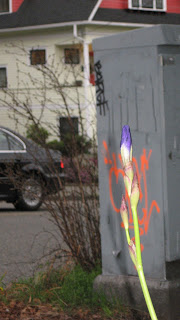
I spent the last week in a happy haze of violets.
It all began when I bought a chunk of violet-scented soap from Lush, my favorite source for hand-made soap and bath bombs.
It was named Gratuitous Violet in an internal rhyme that made me smile. Immediately, it became my favorite soap, a pleasure to slide over my skin, the sumptuous scent lingering on my skin in a shimmer of fragrance for hours. It reminded me of the scent of irises (and I have since learned they share a common chemical compound: ionone) which I love. It is floral without being pretty, sweet without being saccharine, with a hint of dark spiciness. It did not seem familiar to me, and this is probably good, since many people seem to associate the scent with old ladies doused with violets and powder.
The soap soon became an addiction. Alas, on my last trip to Lush on Winter Solstice, I discovered they were discontinuing this soap. I bought the largest piece I could afford and am still doling it out, one little slippery shard at a time, but meanwhile it was time to look for a new supply of violet scent.
I’ve been haunting perfume review sites for some months, eavesdropping on the fabulous discussions of perfumes far too expensive for me to dream of buying a bottle, where I learned about the Perfumed Court, a small company run by three women perfume addicts who got the bright idea of selling samples of decanted perfumes from those big expensive bottles so people like me could try these extravagant pleasures for a minimal price. I searched for “violets” on their web site and found that they offered a violet sampler which I immediately ordered.
While I was waiting for my violet sampler to arrive, I received an email from a Living in Season reader who had read my wistful comment that I had never smelled a real violet as I didn’t believe they grew in Seattle. Not so! She replied. Martha had violets growing in her yard and she volunteered to give me some for my garden. So last Sunday I drove to Martha’s house and we got on our hands and knees and pried them out from among the day lily bulbs.
Martha had several varieties: parma violets with their almost psychedelic red-violet color, and delicate pale apricot colored violets, but the real prize for me were the sweet violets (viola odorata). The tiniest of the lot, you couldn’t smell them unless you got down on your hands and knees and stuck your nose inches from the soil. No wonder violets are so often associated with humility (in the language of the flowers) as they bring us so low to appreciate their fragrance. But the scent! It was intoxicating! Martha told me she picks a few stems and floats them in water. The scent, she said, is so strong it imbues the water with fragrance.
I rushed my transplants home and planted them in my plot in the community garden. The apricot-colored violets have been the happiest with the transfer, but the others are surviving, though they still look a bit crushed. I did pluck three stems of the sweet violets and placed them in a glass of water on my desk where I could periodically reach out and bring it to my nose. The scent is heavenly.
And then my perfume sampler arrived. Thus began a week of prying open tiny glass bottles, one at a time (remembering one of my prized possessions as an adolescent, a box of perfume samples packing in skinny glass ampules, as thin as toothpicks, which you snapped open to release the few drops of liquid inside). Every night I daubed my wrists with violet-themed perfumes, then spent a happy hour trolling the Internet reading perfume reviews.
The jargon amazed and baffled me. Reviewers raved about silage and top notes, threw around terms like dry-off and dark base. It was like being at a wine tasting with a bunch of snobby connoisseurs. One reviewer found notes of blond hay, tobacco, mint, aniseed and violet in a perfume where I smelled merely intense, obnoxious sweetness. To my delight, the perfumes I liked the most were the simplest and the most true to the violet scent: Violetta di Bosco and Violettes de Toulouse, named after the French city which celebrates the violet with a festival every year. I think I will have to visit next year.
 It's not a glamorous photo but it records a sighting that made my heart leap with joy! The first iris bud of the year. Spotted at the corner of Broadway and John in Seattle on the first day of spring.
It's not a glamorous photo but it records a sighting that made my heart leap with joy! The first iris bud of the year. Spotted at the corner of Broadway and John in Seattle on the first day of spring.


